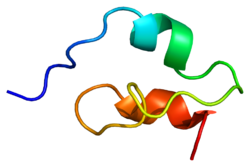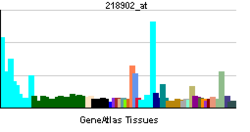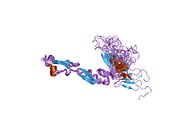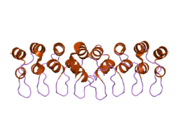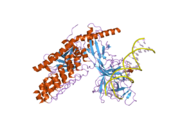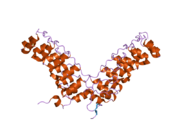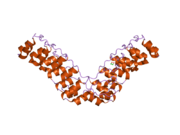- Notch-1
-
"HN1" redirects here. For the nitrogen mustard, see Bis(2-chloroethyl)ethylamine.
Notch homolog 1, translocation-associated (Drosophila), also known as NOTCH1, is a human gene encoding a single-pass transmembrane receptor.
This gene encodes a member of the Notch family. Members of this Type 1 transmembrane protein family share structural characteristics including an extracellular domain consisting of multiple epidermal growth factor-like (EGF) repeats, and an intracellular domain consisting of multiple, different domain types. Notch family members play a role in a variety of developmental processes by controlling cell fate decisions. The Notch signaling network is an evolutionarily conserved intercellular signaling pathway that regulates interactions between physically adjacent cells. In Drosophila, notch interaction with its cell-bound ligands (delta, serrate) establishes an intercellular signaling pathway that plays a key role in development. Homologues of the notch-ligands have also been identified in human, but precise interactions between these ligands and the human notch homologues remain to be determined. This protein is cleaved in the trans-Golgi network, and presented on the cell surface as a heterodimer. This protein functions as a receptor for membrane bound ligands, and may play multiple roles during development.[1] A deficiency can be associated with bicuspid aortic valve.[2]
There is evidence that activated Notch 1 and Notch 3 promote differentiation of progenitor cells into astroglia.[3] Interestingliy, Notch 1, then activated before birth, induces radial glia differentiation,[4] but postnatally induces the differentiation into astrocytes.[5] One study shows that Notch-1 cascade is activated by Reelin in an unidentified way.[6] Reelin and Notch1 cooperate in the development of the dentate gyrus, according to another.[7]
Contents
Interactions
NOTCH1 has been shown to interact with MAML1,[8][9] GSK3B,[10] SNW1,[11][12] Lck,[13] NFKB1,[14][15] RBPJ,[16][17] YY1,[18] NOV,[19] Mothers against decapentaplegic homolog 3[20] and Ubiquitin C.[21]
References
- ^ "Entrez Gene: NOTCH1 Notch homolog 1, translocation-associated (Drosophila)". http://www.ncbi.nlm.nih.gov/sites/entrez?Db=gene&Cmd=ShowDetailView&TermToSearch=4851.
- ^ Stephen H. McKellar MD (August 2007). "Novel NOTCH1 mutations in patients with bicuspid aortic valve disease and thoracic aortic aneurysms". J Thorac Cardiovasc Surg 134 (2): 290–296. doi:10.1016/j.jtcvs.2007.02.041. PMID 17662764.
- ^ Tanigaki K, Nogaki F, Takahashi J, Tashiro K, Kurooka H, Honjo T (January 2001). "Notch1 and Notch3 instructively restrict bFGF-responsive multipotent neural progenitor cells to an astroglial fate". Neuron 29 (1): 45–55. doi:10.1016/S0896-6273(01)00179-9. PMID 11182080. http://linkinghub.elsevier.com/retrieve/pii/S0896-6273(01)00179-9.
- ^ Gaiano N, Nye JS, Fishell G (May 2000). "Radial glial identity is promoted by Notch1 signaling in the murine forebrain". Neuron 26 (2): 395–404. doi:10.1016/S0896-6273(00)81172-1. PMID 10839358. http://linkinghub.elsevier.com/retrieve/pii/S0896-6273(00)81172-1.
- ^ Chambers CB, Peng Y, Nguyen H, Gaiano N, Fishell G, Nye JS (March 2001). "Spatiotemporal selectivity of response to Notch1 signals in mammalian forebrain precursors". Development 128 (5): 689–702. PMID 11171394. http://dev.biologists.org/cgi/pmidlookup?view=long&pmid=11171394.
- ^ Keilani S, Sugaya K (July 2008). "Reelin induces a radial glial phenotype in human neural progenitor cells by activation of Notch-1". BMC Dev. Biol. 8 (1): 69. doi:10.1186/1471-213X-8-69. PMC 2447831. PMID 18593473. http://www.pubmedcentral.nih.gov/articlerender.fcgi?tool=pmcentrez&artid=2447831.
- ^ Sibbe M, Förster E, Basak O, Taylor V, Frotscher M (July 2009). "Reelin and Notch1 cooperate in the development of the dentate gyrus". J. Neurosci. 29 (26): 8578–85. doi:10.1523/JNEUROSCI.0958-09.2009. PMID 19571148.
- ^ Wu, L; Aster J C, Blacklow S C, Lake R, Artavanis-Tsakonas S, Griffin J D (Dec. 2000). "MAML1, a human homologue of Drosophila mastermind, is a transcriptional co-activator for NOTCH receptors". Nat. Genet. (UNITED STATES) 26 (4): 484–9. doi:10.1038/82644. ISSN 1061-4036. PMID 11101851.
- ^ Wu, Lizi; Sun Tao, Kobayashi Karla, Gao Ping, Griffin James D (Nov. 2002). "Identification of a family of mastermind-like transcriptional coactivators for mammalian notch receptors". Mol. Cell. Biol. (United States) 22 (21): 7688–700. doi:10.1128/MCB.22.21.7688-7700.2002. ISSN 0270-7306. PMC 135662. PMID 12370315. http://www.pubmedcentral.nih.gov/articlerender.fcgi?tool=pmcentrez&artid=135662.
- ^ Foltz, Daniel R; Santiago Michelle C, Berechid Bridget E, Nye Jeffrey S (Jun. 2002). "Glycogen synthase kinase-3beta modulates notch signaling and stability". Curr. Biol. (England) 12 (12): 1006–11. doi:10.1016/S0960-9822(02)00888-6. ISSN 0960-9822. PMID 12123574.
- ^ Beatus, P; Lundkvist J, Oberg C, Pedersen K, Lendahl U (Jun. 2001). "The origin of the ankyrin repeat region in Notch intracellular domains is critical for regulation of HES promoter activity". Mech. Dev. (Ireland) 104 (1-2): 3–20. doi:10.1016/S0925-4773(01)00373-2. ISSN 0925-4773. PMID 11404076.
- ^ Zhou, S; Fujimuro M, Hsieh J J, Chen L, Miyamoto A, Weinmaster G, Hayward S D (Apr. 2000). "SKIP, a CBF1-associated protein, interacts with the ankyrin repeat domain of NotchIC To facilitate NotchIC function". Mol. Cell. Biol. (UNITED STATES) 20 (7): 2400–10. doi:10.1128/MCB.20.7.2400-2410.2000. ISSN 0270-7306. PMC 85419. PMID 10713164. http://www.pubmedcentral.nih.gov/articlerender.fcgi?tool=pmcentrez&artid=85419.
- ^ Sade, Hadassah; Krishna Sudhir, Sarin Apurva (Jan. 2004). "The anti-apoptotic effect of Notch-1 requires p56lck-dependent, Akt/PKB-mediated signaling in T cells". J. Biol. Chem. (United States) 279 (4): 2937–44. doi:10.1074/jbc.M309924200. ISSN 0021-9258. PMID 14583609.
- ^ Guan, E; Wang J, Laborda J, Norcross M, Baeuerle P A, Hoffman T (May. 1996). "T cell leukemia-associated human Notch/translocation-associated Notch homologue has I kappa B-like activity and physically interacts with nuclear factor-kappa B proteins in T cells". J. Exp. Med. (UNITED STATES) 183 (5): 2025–32. doi:10.1084/jem.183.5.2025. ISSN 0022-1007. PMC 2192574. PMID 8642313. http://www.pubmedcentral.nih.gov/articlerender.fcgi?tool=pmcentrez&artid=2192574.
- ^ Wang, J; Shelly L, Miele L, Boykins R, Norcross M A, Guan E (Jul. 2001). "Human Notch-1 inhibits NF-kappa B activity in the nucleus through a direct interaction involving a novel domain". J. Immunol. (United States) 167 (1): 289–95. ISSN 0022-1767. PMID 11418662.
- ^ Nam, Yunsun; Weng Andrew P, Aster Jon C, Blacklow Stephen C (Jun. 2003). "Structural requirements for assembly of the CSL.intracellular Notch1.Mastermind-like 1 transcriptional activation complex". J. Biol. Chem. (United States) 278 (23): 21232–9. doi:10.1074/jbc.M301567200. ISSN 0021-9258. PMID 12644465.
- ^ Aster, J C; Robertson E S, Hasserjian R P, Turner J R, Kieff E, Sklar J (Apr. 1997). "Oncogenic forms of NOTCH1 lacking either the primary binding site for RBP-Jkappa or nuclear localization sequences retain the ability to associate with RBP-Jkappa and activate transcription". J. Biol. Chem. (UNITED STATES) 272 (17): 11336–43. doi:10.1074/jbc.272.17.11336. ISSN 0021-9258. PMID 9111040.
- ^ Yeh, Tien-Shun; Lin Yu-Min, Hsieh Rong-Hong, Tseng Min-Jen (Oct. 2003). "Association of transcription factor YY1 with the high molecular weight Notch complex suppresses the transactivation activity of Notch". J. Biol. Chem. (United States) 278 (43): 41963–9. doi:10.1074/jbc.M304353200. ISSN 0021-9258. PMID 12913000.
- ^ Sakamoto, Kei; Yamaguchi Shunji, Ando R, Miyawaki Atsushi, Kabasawa Yuji, Takagi Minoru, Li Chang Long, Perbal Bernard, Katsube Ken-ichi (Aug. 2002). "The nephroblastoma overexpressed gene (NOV/ccn3) protein associates with Notch1 extracellular domain and inhibits myoblast differentiation via Notch signaling pathway". J. Biol. Chem. (United States) 277 (33): 29399–405. doi:10.1074/jbc.M203727200. ISSN 0021-9258. PMID 12050162.
- ^ Blokzijl, Andries; Dahlqvist Camilla, Reissmann Eva, Falk Anna, Moliner Annalena, Lendahl Urban, Ibáñez Carlos F (Nov. 2003). "Cross-talk between the Notch and TGF-beta signaling pathways mediated by interaction of the Notch intracellular domain with Smad3". J. Cell Biol. (United States) 163 (4): 723–8. doi:10.1083/jcb.200305112. ISSN 0021-9525. PMC 2173673. PMID 14638857. http://www.pubmedcentral.nih.gov/articlerender.fcgi?tool=pmcentrez&artid=2173673.
- ^ Chastagner, Patricia; Israël Alain, Brou Christel (2008). "AIP4/Itch regulates Notch receptor degradation in the absence of ligand". PLoS ONE (United States) 3 (7): e2735. Bibcode 2008PLoSO...3.2735C. doi:10.1371/journal.pone.0002735. PMC 2444042. PMID 18628966. http://www.pubmedcentral.nih.gov/articlerender.fcgi?tool=pmcentrez&artid=2444042.
Further reading
- Artavanis-Tsakonas S, Rand MD, Lake RJ (1999). "Notch signaling: cell fate control and signal integration in development.". Science 284 (5415): 770–6. Bibcode 1999Sci...284..770A. doi:10.1126/science.284.5415.770. PMID 10221902.
- Mumm JS, Kopan R (2001). "Notch signaling: from the outside in.". Dev. Biol. 228 (2): 151–65. doi:10.1006/dbio.2000.9960. PMID 11112321.
- Allenspach EJ, Maillard I, Aster JC, Pear WS (2003). "Notch signaling in cancer.". Cancer Biol. Ther. 1 (5): 466–76. PMID 12496471.
- Aster JC (2006). "Deregulated NOTCH signaling in acute T-cell lymphoblastic leukemia/lymphoma: new insights, questions, and opportunities.". Int. J. Hematol. 82 (4): 295–301. doi:10.1532/IJH97.05096. PMID 16298817.
PDB gallery 1pb5: NMR Structure of a Prototype LNR Module from Human Notch11toz: NMR structure of the human NOTCH-1 ligand binding region1ymp: The Crystal Structure of a Partial Mouse Notch-1 Ankyrin Domain: Repeats 4 Through 7 Preserve an Ankyrin Fold1yyh: Crystal structure of the human Notch 1 ankyrin domain2f8x: Crystal structure of activated Notch, CSL and MAML on HES-1 promoter DNA sequence2f8y: Crystal structure of human Notch1 ankyrin repeats to 1.55A resolution.2he0: Crystal structure of a human Notch1 ankyrin domain mutantExternal links
Signaling pathway: notch signaling pathway Receptor on signaling cell Ligand Receptor on receiving cell B trdu: iter (nrpl/grfl/cytl/horl), csrc (lgic, enzr, gprc, igsr, intg, nrpr/grfr/cytr), itra (adap, gbpr, mapk), calc, lipd; path (hedp, wntp, tgfp+mapp, notp, jakp, fsap, hipp, tlrp) Categories:- Human proteins
- Chromosome 9 gene stubs
Wikimedia Foundation. 2010.

